Marcia Thornton Jones's Blog, page 130
October 5, 2017
With Thanks to Librarians by Deborah Lytton
Looking back at the Saturdays I spent with my father at the local library, I can still see the children's librarian helping me to find that perfect book. She was patient and kind and knew every single title on the shelf. In my new series, RUBY STARR, ten-year old Ruby is close with both her school librarian and her local librarian. One of the things that bonds Ruby to these two characters is their mutual love for books. As writers, we connect to librarians professionally as well as through our mutual love for books. When my first MG novel was published in 2009, I didn't know anything about book publishing or what to do once my book was actually released. I learned through the help of a group of other debut authors, the Class of 2k9. We had a website together and cross-promoted on social media and at events, but most importantly, we supported one another with advice and friendship. It was the other writers in the Class of 2k9 who suggested each of us write book guides for librarians and offer them on our websites. In our group emails, I learned about taking my own books to libraries and introducing myself. Our work isn't finished when the book reaches the shelf. In many ways, it is just beginning. Delivering copies to librarians is the best way to make a personal connection because we work together to share books and reading with young people. So much of book promotion becomes about book sales and rankings. But reaching out to librarians is about the words in our stories. It's about sharing those words with the eight-year old reader who is looking for the perfect book to read on a rainy Saturday afternoon. It's a reminder of why we write. I am truly grateful to all the librarians who work with kids every day in schools and in local libraries and encourage them to read and inspire them to love books. It is an honor to work with them. They are changing the world one reader at a time.
Published on October 05, 2017 07:00
October 4, 2017
GUEST POST: 8 steps to illustrating and designing a great book cover (Cathy Thole-Daniels)
Cathy Thole-Daniels (NJ SCBWI regional advisor) happened to illustrate Charlotte Bennardo's EVOLUTION REVOLUTION MG series. She stops by the blog today to offer tip for those hoping to brand out into cover design:
A book cover is a preview of the story within. A great book cover causes the viewer to open the book. It’s as simple as that. Whether on a book shelf or a two inch image on an online bookseller site; the cover entices the viewer to come closer, look further. To read a little and find out more about it. The cover should evoke the same feelings when reading the book as when looking at it and when finishing a book the reader should know why the cover image came to be.
The style of the illustration, the colors, the font, all have to be carefully chosen and work together to create the feel and the mood of the story. Below are ten tips an illustrator/designer should keep in mind when creating a great cover.
Read the entire book. Make notes identifying the key ideas in the content. Look for details to use in the design. Focus on the symbols, characters and images of the book.
Research other covers in the same market. See what’s already been done and try to come up with a fresh perspective. If it’s historical fiction/non-fiction you’ll need to research the time period the story takes place in as well.
Sketch thumbnails. After you have made your notes do some thumbnail sketches, paring down to the essential story elements. Keep in mind the design has to appeal to the age of the audience. Do at least three quick thumbnails, in different design directions, for composition and style. Then enlarge to the printed book size to see if it looks just as good.
Don’t forget to review the cover image at two inches. E-readers are looking at books online and usually only view the initial cover for the first time at that size. Is the cover compelling at a small size?
Color Roughs. Use a color palette that represents the feel of the story and the mood you want to portray. If you are working digitally make sure to work in CMTK mode which is the color mode used when printing the book. The color palette can sometimes look quite different from RGB color mode. If you are working in a program that does not provide CMYK color mode, export the file to Photoshop (as a jpeg or pdf if it does not take that program file) periodically to view the image in CMYK mode.
Feedback is important. Show your thumbnails and color roughs to other illustrators and get feedback on composition and color. Sometimes it’s just hard to see if something isn’t working when you’ve been staring at it for too long. Try looking at it upside down or backwards to break you out of that tunnel vision. If you are working on an indie book it’s important to collaborate with the author and listen to their ideas, whether you use them or not. For the third book in the Evolution Revolution series, Charlotte came up with a great idea for the cover that I hadn’t thought of – have the squirrel (Jack) holding a screw driver!
Typography as well as the layout need to reflect the story. The title should be big and easy to read. Choose a font that reflects the feel and mood you are trying to portray. The text should add to and support the feel of the illustration. If the cover illustration is extensive leave roughly two thirds space for the art. Usually a cover should not have more than two fonts. Too many font styles can be too much visual competition.
For Book Series Use Similar Design Elements. This means a consistent use of imagery or at least style, type, and/or layout. There should be something to tie all of your cover designs together, this can be a common color, a common typographical style, a common illustration/photography style. Make each cover unique, but also make each cover cohesive with the rest.
~
Cathy Thole-Daniels's work:
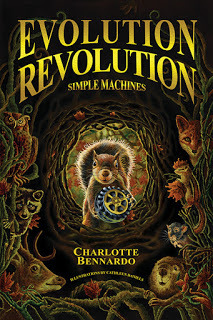

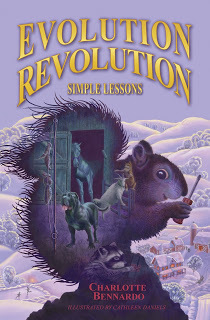
A book cover is a preview of the story within. A great book cover causes the viewer to open the book. It’s as simple as that. Whether on a book shelf or a two inch image on an online bookseller site; the cover entices the viewer to come closer, look further. To read a little and find out more about it. The cover should evoke the same feelings when reading the book as when looking at it and when finishing a book the reader should know why the cover image came to be.
The style of the illustration, the colors, the font, all have to be carefully chosen and work together to create the feel and the mood of the story. Below are ten tips an illustrator/designer should keep in mind when creating a great cover.
Read the entire book. Make notes identifying the key ideas in the content. Look for details to use in the design. Focus on the symbols, characters and images of the book.
Research other covers in the same market. See what’s already been done and try to come up with a fresh perspective. If it’s historical fiction/non-fiction you’ll need to research the time period the story takes place in as well.
Sketch thumbnails. After you have made your notes do some thumbnail sketches, paring down to the essential story elements. Keep in mind the design has to appeal to the age of the audience. Do at least three quick thumbnails, in different design directions, for composition and style. Then enlarge to the printed book size to see if it looks just as good.
Don’t forget to review the cover image at two inches. E-readers are looking at books online and usually only view the initial cover for the first time at that size. Is the cover compelling at a small size?
Color Roughs. Use a color palette that represents the feel of the story and the mood you want to portray. If you are working digitally make sure to work in CMTK mode which is the color mode used when printing the book. The color palette can sometimes look quite different from RGB color mode. If you are working in a program that does not provide CMYK color mode, export the file to Photoshop (as a jpeg or pdf if it does not take that program file) periodically to view the image in CMYK mode.
Feedback is important. Show your thumbnails and color roughs to other illustrators and get feedback on composition and color. Sometimes it’s just hard to see if something isn’t working when you’ve been staring at it for too long. Try looking at it upside down or backwards to break you out of that tunnel vision. If you are working on an indie book it’s important to collaborate with the author and listen to their ideas, whether you use them or not. For the third book in the Evolution Revolution series, Charlotte came up with a great idea for the cover that I hadn’t thought of – have the squirrel (Jack) holding a screw driver!
Typography as well as the layout need to reflect the story. The title should be big and easy to read. Choose a font that reflects the feel and mood you are trying to portray. The text should add to and support the feel of the illustration. If the cover illustration is extensive leave roughly two thirds space for the art. Usually a cover should not have more than two fonts. Too many font styles can be too much visual competition.
For Book Series Use Similar Design Elements. This means a consistent use of imagery or at least style, type, and/or layout. There should be something to tie all of your cover designs together, this can be a common color, a common typographical style, a common illustration/photography style. Make each cover unique, but also make each cover cohesive with the rest.
~
Cathy Thole-Daniels's work:



Published on October 04, 2017 05:00
October 3, 2017
The Summer a Library Saved My Life
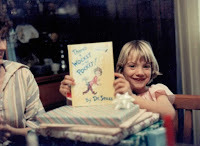 wee me getting a much-loved
wee me getting a much-lovedand oft-checked-out book
for my birthday.Libraries have long been an important part of my life. Whatever town we lived in -- and there were a lot of them-- my mother took us to get library cards, and we (me and my 4 siblings) always checked out the maximum number of books. If we checked out a book multiple times, that book just might appear as a wrapped gift on a birthday or Christmas. But no one of us kids loved books more than I did.
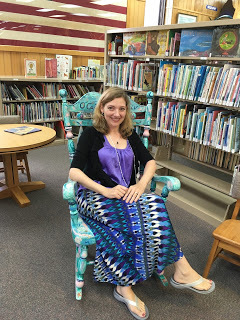 Me (a few decades older than 11)
Me (a few decades older than 11)sitting in a very special chair
in the Children's Dept.
at the St. Joe LibraryOne summer when I was about eleven, our parents split the kids up between grandparents so they could have a couple of child-free weeks. My (mischievous) brother Ken and I got put with Grandma and Granddaddy Dykes in Port St. Joe, Florida. I'm not sure why, but that time I got really homesick. I was crying and crying and begged my mom to come get me. My grandmother, in her infinite wisdom, hugged me and gave me cornbread and took me to the library.
There a sweet librarian (whose name I wish I could recall!) showed me where the horse books were and led me to the colorful rug that was cushioned with fluffy pillows. My grandma sat with me while I read books and forgot for a couple of hours about home and missing my mama. The sweet refuge of stories was exactly what I needed. We went to the library every day the rest of that summer. I'm pretty sure I wouldn't have survived that trip if not for my Grandma and the Port St. Joe Library.*
So, librarians, if you're reading this: what you do is important. You never know whose life you are saving when you welcome them in with a smile and a well-stocked shelf of horse books. Thank you!
*Read a more detailed version of this story at Live Your Poem.
----------------
Irene Latham is the author of more than a dozen current and forthcoming poetry, fiction and picture books for children and adults, including Leaving Gee's Bend, 2011 ALLA Children's Book of the Year. Winner of the 2016 ILA Lee Bennett Hopkins Promising Poet Award, she also serves as poetry editor for Birmingham Arts Journal.
Published on October 03, 2017 03:30
October 2, 2017
Waiting for Wednesday by Ann Haywood Leal
 She took us every Wednesday without fail. After dinner, Mom would get behind the wheel of our white Chevy station wagon, and my brother and I would scoot into the back seat with our teetering stacks of library books and head to the Auburn Public Library.
She took us every Wednesday without fail. After dinner, Mom would get behind the wheel of our white Chevy station wagon, and my brother and I would scoot into the back seat with our teetering stacks of library books and head to the Auburn Public Library. It was a tricky balance, checking out just the right amount of books to last until the next week. You all know that feeling: that horrible, disjointed, queasiness of being without a book. Possibly the only worse feeling would be if you had only a few pages of the last chapter left and you had to bring it back! Sure, you could renew it, but what-if-someone-had-put-it-on-reserve-and-Mrs.-Barnhart-the-Children's-Librarian-kindly-asked-you-to-hand-it-over! Okay, there was something worse. What if it was a Nancy Drew book and Nancy had yet to tie things up with The Clue of the Tapping Heels??
I can still smell the scent of the library foyer. Even now, my heart still speeds up when I think about taking a right through those double doors and run-walking over to the Nancy Drew section. I had already pored over the list of titles on the yellow back cover, memorizing the ones I had yet to get my hands on. And would they be on the shelf today? Would someone have finally returned the copy of Nancy's Mysterious Letter?!
 But the true holy grail was two book shelves over to the left. You probably already know what I'm going to say . . . <deep breath> . . . THE JUDY BLUME SECTION. (You might be asking me: Ann, did that really require all caps? And of course I'd have to respond, yes. Yes, it did, because I'm not sure if I can even continue our FB friendship, if you think otherwise. :) ) And what if . . . <another deep breath and maybe a quick drink of water> . . . the library's only copy of ARE YOU THERE GOD? IT'S ME, MARGARET. was right there on the shelf?! Sometimes it could be a decoy book that fooled you. The cover might have been a slightly brighter yellow than the real thing, and for a brief moment you would have felt cheated. But when you had the real thing in your sweaty hands, it made Wednesday truly worth waiting for.
But the true holy grail was two book shelves over to the left. You probably already know what I'm going to say . . . <deep breath> . . . THE JUDY BLUME SECTION. (You might be asking me: Ann, did that really require all caps? And of course I'd have to respond, yes. Yes, it did, because I'm not sure if I can even continue our FB friendship, if you think otherwise. :) ) And what if . . . <another deep breath and maybe a quick drink of water> . . . the library's only copy of ARE YOU THERE GOD? IT'S ME, MARGARET. was right there on the shelf?! Sometimes it could be a decoy book that fooled you. The cover might have been a slightly brighter yellow than the real thing, and for a brief moment you would have felt cheated. But when you had the real thing in your sweaty hands, it made Wednesday truly worth waiting for. Have a great week, because guess what? Only two more days until Wednesday!
Have a great week, because guess what? Only two more days until Wednesday!
Published on October 02, 2017 13:30
September 28, 2017
Sketching For Writers Who Can't Draw...
Character Sketches – For Writers Who Can’t Draw
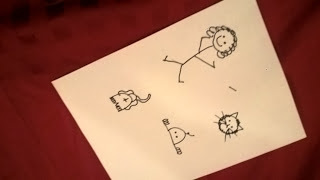
I can draw – stick figures. Simple smiley faces. A house with clouds, like a five-year-old. When it comes to writing, I have to use anything other than drawing to sketch my characters. Many authors use the method below to help them get to know their characters. I find this also works great when I’m stuck on a plot point, or a dialogue scene or simply if my character would like sushi. The first thing I do when a character has introduced them self to me (in my head), is ask what they look like. Currently, I’m working on a horror short story where there’s a female doctor. She told me she’s Pacific Islander, so I hunted through Google Images for Pacific Islander people. I found a person whom I feel Dr. Sefina Mai looks like. (I add the pic to my sketch, but I can’t reproduce here without paying a royalty fee.) Now that I see her face, I can describe her wavy dark tresses, her eyes as brown as sable, and the wide set of noble cheekbones, but is that a small scar I see across her forehead from a rock thrown by a friend? Next, I ask her a few personal questions. What’s her favorite hobby? Is she interested in someone? Does she hate snakes like me? What’s her favorite food? Color? Movie? What is her biggest wish- and her greatest fear? While she talks, I make notes on her not-so-nice features and what’s she’s not telling me. She’s impatient. I know that from the one-word answers to the jiggling foot. Her eyes constantly seek out the clock. Apparently fashion isn’t a must for her; she’s wearing basic black pants, a white shirt that’s slightly gray and worn in the elbows, and black shoes that are too scuffed. Is that a bit of toe peeking out? Not really the professional outfit a doctor on the cusp of a revolutionary medical breakthrough should be seen wearing. She’s terribly blunt, too- “I have to get back to my lab. Hurry up.” I joke that I’m her Creator and can take as much time as I like. She snorts; she has no sense of humor, either. The last info I need from her are age, place of birth, education, where does she live now, any friends? Enemies? Having all the basics, I make what they call in the business a One Sheet (authors use this a a basic this-is-who-I-am). I am now ready to write my story because I know Dr. Mai. Oh, she’ll still surprise me by making an unexpected joke, showing interest in someone when she should be focusing on her patient, or thinking about a regret she hasn’t shared with me. I know she will do something shocking, but she’s keeping her own counsel about it. This ‘sketch’ is like an illustrator's rough draft because it’s not complete and is subject to change, works well for all characters. Minor characters don’t have to be so detailed, like people in the background of a picture. I glance at each sketch before I start writing and refresh my memory of our little chat. By the time the story is polished and off to an editor, this sketch may be several pages long. Or her picture could change. Just remember to keep it short and punchy- no need to write a proper novel on your character. Here’s what Dr. Mai’s initial sketch looks like:
Dr. Sefina Mai· Born on island of Guam (Pacific Islander).· 38 years old. · Single. · Medical doctor specializing in reconstructive surgery. Researching regeneration. Works out of own private lab which is funded by small surgical practice. · Lives in a small stone cottage outside the city. · No pets, no children, no husband or partner.· Her work, her research, is her passion. It consumes all her money, time, and attention. If she could just perfect her serum, she’d change millions of lives, but she refuses to be chained to a university, a pharmaceutical company, or the medical board. She will not be hindered by bureaucracy, politics, money, or her hypocritically moral colleagues.· She dresses basically; black pants, white shirt, to avoid wasting time thinking about what to wear. Her shoes are scuffed and she will have to take the time to replace them. There’s a hole in the left one, near her big toe, which will allow snow in. · Food is food, whatever is available and doesn’t take time away from her work, but that take-out in the fridge is green-and growing. Probably not good to eat, it must be old.· Her surgical practice is small, and not very fancy, but it’s steady. She tries to help those who are most desperate, those needing a facial or body reconstruction because of accident, illness, or injury.· Meeting Mr. Stein will change the course of her life- and death. A sketch supplies authors with a firm base to start from. Whether you’re writing middle grade or young adult (instead of job, list school, sports played, clubs/religion a part of, etc.) or even adult, fiction or non-fic, it’s a quick reference when you stop to think, ‘What would my character do?’ Refer to the sketch and you’ll likely get the answer. And with NaNoWriMo coming up (National Novel Writing Month in November), this is a good way to get a handle on the characters before you get stuck because you don’t know how they would react, or you have to think what color eyes you gave them, etc. You don't have to use all the information, but it's there in case you need it.
So happy sketching!

I can draw – stick figures. Simple smiley faces. A house with clouds, like a five-year-old. When it comes to writing, I have to use anything other than drawing to sketch my characters. Many authors use the method below to help them get to know their characters. I find this also works great when I’m stuck on a plot point, or a dialogue scene or simply if my character would like sushi. The first thing I do when a character has introduced them self to me (in my head), is ask what they look like. Currently, I’m working on a horror short story where there’s a female doctor. She told me she’s Pacific Islander, so I hunted through Google Images for Pacific Islander people. I found a person whom I feel Dr. Sefina Mai looks like. (I add the pic to my sketch, but I can’t reproduce here without paying a royalty fee.) Now that I see her face, I can describe her wavy dark tresses, her eyes as brown as sable, and the wide set of noble cheekbones, but is that a small scar I see across her forehead from a rock thrown by a friend? Next, I ask her a few personal questions. What’s her favorite hobby? Is she interested in someone? Does she hate snakes like me? What’s her favorite food? Color? Movie? What is her biggest wish- and her greatest fear? While she talks, I make notes on her not-so-nice features and what’s she’s not telling me. She’s impatient. I know that from the one-word answers to the jiggling foot. Her eyes constantly seek out the clock. Apparently fashion isn’t a must for her; she’s wearing basic black pants, a white shirt that’s slightly gray and worn in the elbows, and black shoes that are too scuffed. Is that a bit of toe peeking out? Not really the professional outfit a doctor on the cusp of a revolutionary medical breakthrough should be seen wearing. She’s terribly blunt, too- “I have to get back to my lab. Hurry up.” I joke that I’m her Creator and can take as much time as I like. She snorts; she has no sense of humor, either. The last info I need from her are age, place of birth, education, where does she live now, any friends? Enemies? Having all the basics, I make what they call in the business a One Sheet (authors use this a a basic this-is-who-I-am). I am now ready to write my story because I know Dr. Mai. Oh, she’ll still surprise me by making an unexpected joke, showing interest in someone when she should be focusing on her patient, or thinking about a regret she hasn’t shared with me. I know she will do something shocking, but she’s keeping her own counsel about it. This ‘sketch’ is like an illustrator's rough draft because it’s not complete and is subject to change, works well for all characters. Minor characters don’t have to be so detailed, like people in the background of a picture. I glance at each sketch before I start writing and refresh my memory of our little chat. By the time the story is polished and off to an editor, this sketch may be several pages long. Or her picture could change. Just remember to keep it short and punchy- no need to write a proper novel on your character. Here’s what Dr. Mai’s initial sketch looks like:
Dr. Sefina Mai· Born on island of Guam (Pacific Islander).· 38 years old. · Single. · Medical doctor specializing in reconstructive surgery. Researching regeneration. Works out of own private lab which is funded by small surgical practice. · Lives in a small stone cottage outside the city. · No pets, no children, no husband or partner.· Her work, her research, is her passion. It consumes all her money, time, and attention. If she could just perfect her serum, she’d change millions of lives, but she refuses to be chained to a university, a pharmaceutical company, or the medical board. She will not be hindered by bureaucracy, politics, money, or her hypocritically moral colleagues.· She dresses basically; black pants, white shirt, to avoid wasting time thinking about what to wear. Her shoes are scuffed and she will have to take the time to replace them. There’s a hole in the left one, near her big toe, which will allow snow in. · Food is food, whatever is available and doesn’t take time away from her work, but that take-out in the fridge is green-and growing. Probably not good to eat, it must be old.· Her surgical practice is small, and not very fancy, but it’s steady. She tries to help those who are most desperate, those needing a facial or body reconstruction because of accident, illness, or injury.· Meeting Mr. Stein will change the course of her life- and death. A sketch supplies authors with a firm base to start from. Whether you’re writing middle grade or young adult (instead of job, list school, sports played, clubs/religion a part of, etc.) or even adult, fiction or non-fic, it’s a quick reference when you stop to think, ‘What would my character do?’ Refer to the sketch and you’ll likely get the answer. And with NaNoWriMo coming up (National Novel Writing Month in November), this is a good way to get a handle on the characters before you get stuck because you don’t know how they would react, or you have to think what color eyes you gave them, etc. You don't have to use all the information, but it's there in case you need it.
So happy sketching!
Published on September 28, 2017 22:03
September 27, 2017
Introducing Dusti Bowling
I’m so excited to be joining the lovely and talented folks here at Smack Dab in the Middle. It was middle grade literature that truly awakened my love of reading as a child, and I couldn’t be more thrilled that I now get to write middle grade stories for children (and many grown-ups, too!).
I was in second grade when my parents divorced. The stories I read during that time and the years afterward were my friends, my escape, and my therapy. They were my windows into other worlds and times far, far away from my pain. They brought me great comfort, and I think I enjoy writing middle grade so much now because I can vividly recall those feelings and tap into them.
I didn’t always know I wanted to write middle grade. I started out writing chapter and picture books that are currently hidden away. I then tried my hand at some young adult stories, which I self published with a bit of success. While I enjoyed writing young adult, I never felt the connection to it that I feel with middle grade. As soon as I wrote the first chapter of my first middle grade book, INSIGNIFICANT EVENTS IN THE LIFE OF A CACTUS, I knew I had found my truest writing voice. There’s something really special about middle grade literature, about that time in our lives when we’re learning so many new things about the world and who we are as people. When so many changes are happening within us, and even though we’re on the brink of young adulthood, it’s still okay to be silly. It is a time of great hope, when anything is possible.
I currently live in Arizona with my husband and three daughters. I do my best to find snippets of writing time in between homeschooling, cooking, swimming, and enjoying the outdoors when it’s not over a hundred degrees outside. Despite the heat, I have a passionate love for the Arizona desert, which has inspired the settings in both INSIGNIFICANT EVENTS IN THE LIFE OF A CACTUS and my next middle grade novel (releasing in 2018), TWENTY-FOUR HOURS IN NOWHERE.
I am so grateful for this journey I’m on, for the amazing people I’ve met, and for the incredible people I get to work with. I’m excited to share my love of middle grade literature on Smack Dab in the Middle, and I hope to create many more stories to share with the world.
I was in second grade when my parents divorced. The stories I read during that time and the years afterward were my friends, my escape, and my therapy. They were my windows into other worlds and times far, far away from my pain. They brought me great comfort, and I think I enjoy writing middle grade so much now because I can vividly recall those feelings and tap into them.
I didn’t always know I wanted to write middle grade. I started out writing chapter and picture books that are currently hidden away. I then tried my hand at some young adult stories, which I self published with a bit of success. While I enjoyed writing young adult, I never felt the connection to it that I feel with middle grade. As soon as I wrote the first chapter of my first middle grade book, INSIGNIFICANT EVENTS IN THE LIFE OF A CACTUS, I knew I had found my truest writing voice. There’s something really special about middle grade literature, about that time in our lives when we’re learning so many new things about the world and who we are as people. When so many changes are happening within us, and even though we’re on the brink of young adulthood, it’s still okay to be silly. It is a time of great hope, when anything is possible.
I currently live in Arizona with my husband and three daughters. I do my best to find snippets of writing time in between homeschooling, cooking, swimming, and enjoying the outdoors when it’s not over a hundred degrees outside. Despite the heat, I have a passionate love for the Arizona desert, which has inspired the settings in both INSIGNIFICANT EVENTS IN THE LIFE OF A CACTUS and my next middle grade novel (releasing in 2018), TWENTY-FOUR HOURS IN NOWHERE.
I am so grateful for this journey I’m on, for the amazing people I’ve met, and for the incredible people I get to work with. I’m excited to share my love of middle grade literature on Smack Dab in the Middle, and I hope to create many more stories to share with the world.
Published on September 27, 2017 22:00
September 26, 2017
INTERVIEW WITH ILLUSTRATOR ROXIE MUNRO
I (Holly Schindler, blog administrator) was delighted to get a chance to chat recently with Roxie Monro, an artist and illustrator for a wide swath of ages. Here, she gives us some insights into her creative process, the business side of art, and even lets us take a peek at her work station:
You’ve had some amazing accomplishments as an artist—including making the cover of THE NEW YORKER! Many of us at Smack Dab are familiar with the submission process for fiction; how is the process different or similar for artwork?
It’s been a long time since I’ve submitted, but I don’t think the process has changed much, except for the fact that when I got accepted, there was one art editor…Lee Lorenz. He chose (with the New Yorker’s editor at the time) cartoons, spots, covers – all the art. Now there are several different editors for cartoons, spots/illustration, photography, and covers. I began by submitting spots and was immediately accepted. Contributed them for several years; I was living in Washington DC at the time and took the train up to New York City a few times a year. I was so lucky – a couple years later I submitted two cover paintings, and they bought one right away. I immediately moved to NYC. I did not know a single person in the city. I soon made friends, though, with other cartoonists and artists.
In addition to being an artist, you’re also a writer. What brought you to the world of children’s books?
I’d been in NYC for a couple years and was trying to make a living freelancing and doing fine art. I constantly walked the city, feasting on the city life, the tall buildings, and busy streets. I decided to try to do adult book jacket covers – maybe city scenes. One day an art director suggested I see a children’s book editor she knew. I snippily said, “I don’t do cute; I don’t do bunnies and bears,” but, needing the work, I made the appointment with Donna Brooks at Dodd Mead (later Dutton Children’s Books). She said, “I think you have something to offer children. Call me if you get an idea.” One week later, waking up at 7AM, before my closed eyes I saw, in red capital letters against the black of sleep, “The Inside-Outside Book of New York City.” I called her up and said I had a title, but no idea if it was a book. I knew nothing about page turn, what the gutter was, how many pages are in a standard book, trim size – nothing. Regarding writing, I had qualified for Honors English in college and written a couple newspaper articles, but that was it. But I did the book, and it went on to win the NY Times Best Illustrated Children’s Book Award and was on Time magazine’s Best of the Year List. So, I figured I’d stick with doing kid’s books. ;-))
What’s your process as a children’s illustrator? What comes first—the story, which you then illustrate, or do you complete several illustrative pieces and then tie them together with a narrative thread?
The latter, more or less. I’m a “visual thinker.” After I get an idea or a concept, I’ll do a few sketches, and then a simple storyboard and dummy. That’s what I present with the proposal to my editor, not the actual picture book manuscript. Then I do research, refine the sketches, and do the art. I do not write the text until the art is completely done. Kind of the reverse of the way most editors prefer.
What are your favorite illustration tools? (Do you rely primarily on traditional media? Have any favorite brushes, pencils, etc.? If digital, what are your favorite programs, drawing tablets, etc.?)
I don’t do digital art. I think there are basically two kinds of illustrators. Some, like my buddy Paul Zelinsky, may use a completely different media with each book – sometimes oil in a classical painting style, or maybe a cartoon-y method, with pastels or colored pencils, or sometimes he goes digital. I am the opposite. I use one favorite type of paper, colored inks, one familiar line thickness with my trusty Radiograph. I want to know my media thoroughly, so that my brain power doesn’t go into trying to figure out new materials. To paraphrase Flaubert: “… be regular and orderly in life, so that you may be violent and original in your work.” I save experimentation not for different media, but for the idea, the compositions, color, pattern. The Horn Book said of my latest book Masterpiece Mix: “Like so many of Munro’s books, this one is hard to categorize.” I liked that.
Any pictures you can show us of an illustration in various stages of completion?
Here’s some work from my drawing table making Masterpiece Mix.
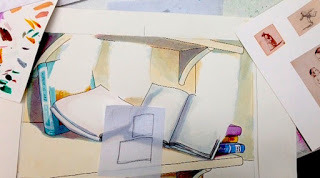
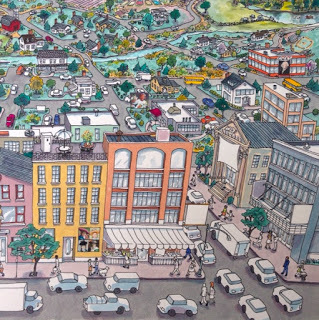
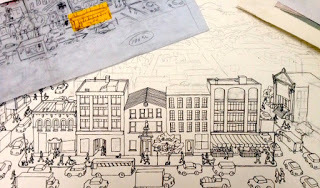
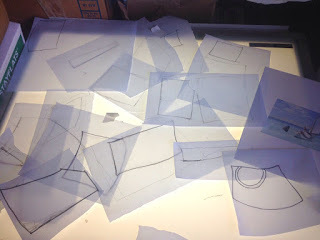

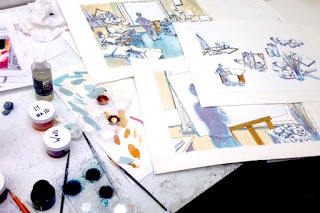
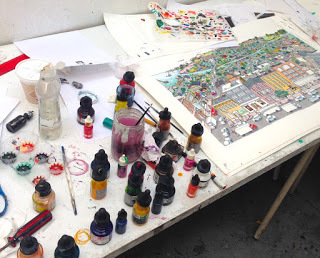
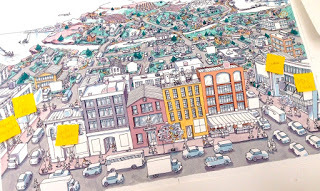
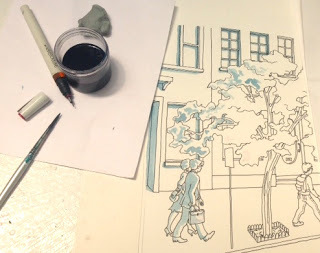
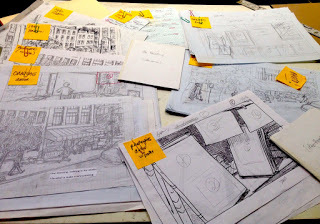
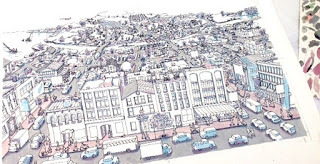
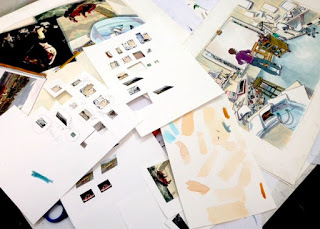
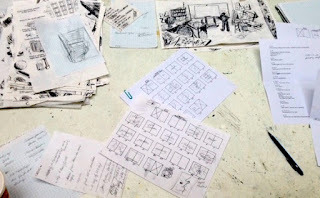
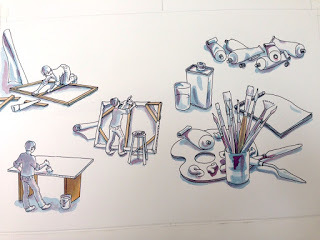
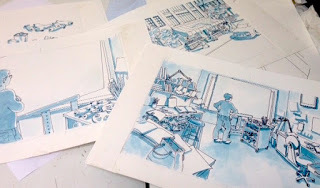
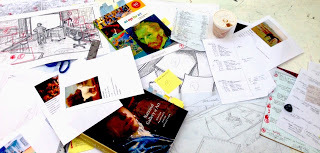
What’s one piece of advice you’d give anyone looking to make a living as an artist or illustrator?
Develop your own style (which evolves over time) and don’t worry about what’s trendy….to thine own self be true.
What can we look forward to next?
I have a book coming out in February called Rodent Rascals. The device is that all the rodents are shown actual size, which can get tricky because some critters, like the capybara, grow the size of a really large dog, so its whole body can’t fit on a page. Am waiting confirmation on another idea - a paper-engineered book. Like many of my books, this one is interactive and has an element of “gamification.” It’s a lot of work – I’ve done four moveable books, and did the engineering myself, which is hard and a real learning curve. But it’s fun!
~
Thank you, Roxie, for taking the time to talk with us! And please be sure to continue to keep up with Roxie online:
WEBSITE: www.roxiemunro.com
TWITTER: https://twitter.com/roxiemunro
FACEBOOK: https://www.facebook.com/RoxieMunroStudio
KidLitTV: http://kidlit.tv/
KIWiSTORYBOOKS: http://www.kiwistorybooks.com/
PUBLISHERS MARKETPLACE PAGE:publishersmarketplace.com/members/roxiemunro/
BLOG: http://roxiemunro.wordpress.com/
SCHOOL TUBE CHANNEL: schooltube.com/channel/roxie_munro_author/
AMAZON PAGE: amazon.com/author/roxiemunro
INKTHINKTANK: http://inkthinktank.com/
PINTEREST: https://www.pinterest.com/roxiemunro/
App & Trailer Developer OCG STUDIOS:http://www.ocgstudios.com/
You’ve had some amazing accomplishments as an artist—including making the cover of THE NEW YORKER! Many of us at Smack Dab are familiar with the submission process for fiction; how is the process different or similar for artwork?
It’s been a long time since I’ve submitted, but I don’t think the process has changed much, except for the fact that when I got accepted, there was one art editor…Lee Lorenz. He chose (with the New Yorker’s editor at the time) cartoons, spots, covers – all the art. Now there are several different editors for cartoons, spots/illustration, photography, and covers. I began by submitting spots and was immediately accepted. Contributed them for several years; I was living in Washington DC at the time and took the train up to New York City a few times a year. I was so lucky – a couple years later I submitted two cover paintings, and they bought one right away. I immediately moved to NYC. I did not know a single person in the city. I soon made friends, though, with other cartoonists and artists.
In addition to being an artist, you’re also a writer. What brought you to the world of children’s books?
I’d been in NYC for a couple years and was trying to make a living freelancing and doing fine art. I constantly walked the city, feasting on the city life, the tall buildings, and busy streets. I decided to try to do adult book jacket covers – maybe city scenes. One day an art director suggested I see a children’s book editor she knew. I snippily said, “I don’t do cute; I don’t do bunnies and bears,” but, needing the work, I made the appointment with Donna Brooks at Dodd Mead (later Dutton Children’s Books). She said, “I think you have something to offer children. Call me if you get an idea.” One week later, waking up at 7AM, before my closed eyes I saw, in red capital letters against the black of sleep, “The Inside-Outside Book of New York City.” I called her up and said I had a title, but no idea if it was a book. I knew nothing about page turn, what the gutter was, how many pages are in a standard book, trim size – nothing. Regarding writing, I had qualified for Honors English in college and written a couple newspaper articles, but that was it. But I did the book, and it went on to win the NY Times Best Illustrated Children’s Book Award and was on Time magazine’s Best of the Year List. So, I figured I’d stick with doing kid’s books. ;-))
What’s your process as a children’s illustrator? What comes first—the story, which you then illustrate, or do you complete several illustrative pieces and then tie them together with a narrative thread?
The latter, more or less. I’m a “visual thinker.” After I get an idea or a concept, I’ll do a few sketches, and then a simple storyboard and dummy. That’s what I present with the proposal to my editor, not the actual picture book manuscript. Then I do research, refine the sketches, and do the art. I do not write the text until the art is completely done. Kind of the reverse of the way most editors prefer.
What are your favorite illustration tools? (Do you rely primarily on traditional media? Have any favorite brushes, pencils, etc.? If digital, what are your favorite programs, drawing tablets, etc.?)
I don’t do digital art. I think there are basically two kinds of illustrators. Some, like my buddy Paul Zelinsky, may use a completely different media with each book – sometimes oil in a classical painting style, or maybe a cartoon-y method, with pastels or colored pencils, or sometimes he goes digital. I am the opposite. I use one favorite type of paper, colored inks, one familiar line thickness with my trusty Radiograph. I want to know my media thoroughly, so that my brain power doesn’t go into trying to figure out new materials. To paraphrase Flaubert: “… be regular and orderly in life, so that you may be violent and original in your work.” I save experimentation not for different media, but for the idea, the compositions, color, pattern. The Horn Book said of my latest book Masterpiece Mix: “Like so many of Munro’s books, this one is hard to categorize.” I liked that.
Any pictures you can show us of an illustration in various stages of completion?
Here’s some work from my drawing table making Masterpiece Mix.
















What’s one piece of advice you’d give anyone looking to make a living as an artist or illustrator?
Develop your own style (which evolves over time) and don’t worry about what’s trendy….to thine own self be true.
What can we look forward to next?
I have a book coming out in February called Rodent Rascals. The device is that all the rodents are shown actual size, which can get tricky because some critters, like the capybara, grow the size of a really large dog, so its whole body can’t fit on a page. Am waiting confirmation on another idea - a paper-engineered book. Like many of my books, this one is interactive and has an element of “gamification.” It’s a lot of work – I’ve done four moveable books, and did the engineering myself, which is hard and a real learning curve. But it’s fun!
~
Thank you, Roxie, for taking the time to talk with us! And please be sure to continue to keep up with Roxie online:
WEBSITE: www.roxiemunro.com
TWITTER: https://twitter.com/roxiemunro
FACEBOOK: https://www.facebook.com/RoxieMunroStudio
KidLitTV: http://kidlit.tv/
KIWiSTORYBOOKS: http://www.kiwistorybooks.com/
PUBLISHERS MARKETPLACE PAGE:publishersmarketplace.com/members/roxiemunro/
BLOG: http://roxiemunro.wordpress.com/
SCHOOL TUBE CHANNEL: schooltube.com/channel/roxie_munro_author/
AMAZON PAGE: amazon.com/author/roxiemunro
INKTHINKTANK: http://inkthinktank.com/
PINTEREST: https://www.pinterest.com/roxiemunro/
App & Trailer Developer OCG STUDIOS:http://www.ocgstudios.com/
Published on September 26, 2017 05:00
September 25, 2017
BEST TEACHER EVER (HOLLY SCHINDLER)
I’ll be honest. At first, I wasn’t much of a fan. In fact, in the beginning, this particular professor drove me crazy.
His name was Dr. B., and I had him for Intro to Literary Criticism. First semester of my sophomore year of college.
And the first paper I wrote for him, I got a big fat “C.”
I was not used to “C”s in any class really—especially not English. But I visited him in his office. We discussed the paper. I rewrote it.
I improved. I got a “B” on the rewrite.
I wrote another paper.
“C.”
The guy, in a word, was tough. Unrelentingly.
I went back to his office. I discussed. I rewrote.
I'll admit it—I cussed a lot, too.
And then, after a few weeks, things really started to click. I started to understand what he was asking me to do. I wrote a feminist paper on The Scarlet Letter, and the first draft of it made him cock his head and say, “I never thought about that before.”
On the final version of that paper, he wrote, “This is a dandy of an essay.”
I had that thing on the fridge till it crumbled off.
In short, I worked my tail off for Dr. B. I came away with my precious “A” for the course. But I came away with far more than that. I came away with a solid feeling for what literary criticism was. I came away with—get this—loving teachers who were tough. Because, as I found out, there was nothing quite so satisfying as meeting their high expectations.
I took three more courses with Dr. B.—undergrad and grad level. While I was still in school, I wound up getting a short critical piece on a Howard Nemerov poem published in The Explicator, which I was sure to share with him.
He asked for a copy to keep. When I handed it to him, he told me, “I’m going to get to point to a big published work someday and say, ‘She was in my class.’”
I was on cloud nine.
It took several years after leaving college to sell my first novel. When I did, I immediately thought of Dr. B. But when I looked him up, I was saddened to learn that he had passed away just a few months earlier.
The thing is, though, the more time passes and the more I find myself having to rise to new challenges and forge ahead, I think of what I learned from Dr. B., and I know that the truth of the matter is, I'm the one who gets to say, “I was in his class.”
Published on September 25, 2017 05:00
September 22, 2017
Fear of Imagination: Smack Dab in the Imagination by Dia Calhoun
“You have an overactive imagination.”
This is a judgment people with less imagination make on those with more imagination—usually adults to children. Here is what these adults are really saying:
I don’t understand your imagination. I can’t contain it. Having so much imagination is not normal. So STOP! Squash your imagination. Turn it off. Because it FRIGHTENS me.
In our over-rational world, an abundant imagination is not only considered to be of little value, but also considered to be dangerous.
Children hearing such messages can become frightened of their own imaginations. This fills me with sadness, and a sense of waste. We think the problems of our world will be solved solely by technology. By the exercise of our rational minds. Look around! Can you honestly say that our single-minded reliance on one function of our brain hasn’t led us to the brink of social and ecological disaster?
We need imagination so desperately now. We need it in abundance, streaming out from us like stars to create paths forward we cannot yet see. We need to encourage imagination, not only in children, but in everyone. So turn on imagination everywhere you find it. Fan it into a flame.
But the most important thing we need to do is look into ourselves and ask: Why does imagination frighten me? Why do the imaginations of children frighten me? And more pointedly, how does my own imagination frighten me?
Then we will have a place to begin.
Published on September 22, 2017 22:00
September 20, 2017
The Read Aloud - A Favorite for Everyone
So who remembers coming in from lunch recess all hot and sweaty, getting a nice long drink at the water fountain, and then putting your head down on your desk in anticipation of the next chapter of the class read aloud? This is the setting of some of my fondest book memories. Not only was it a wonderful and relaxing way to transition into whatever we happened to be doing in class later that afternoon, but it was such an amazing way to experience a story. Whether it was one of the Laura Ingalls Wilder books or Island of the Blue Dolphins, I still remember closing my eyes and picturing what was happening in the story as my teacher read aloud.
Those are my childhood read aloud memories, but I also have teacher read aloud memories. When I got my first teaching job, one of the things I looked forward to most was the opportunity to pass along that read aloud experience to my students. Choosing what books I would read to my classes was great fun for me. And I have to confess, there may have been more than a few times during my thirteen years of teaching third grade that my read aloud time went a little longer than it should have. But what is a teacher to do when her students beg her to read just one more chapter?
Those are my childhood read aloud memories, but I also have teacher read aloud memories. When I got my first teaching job, one of the things I looked forward to most was the opportunity to pass along that read aloud experience to my students. Choosing what books I would read to my classes was great fun for me. And I have to confess, there may have been more than a few times during my thirteen years of teaching third grade that my read aloud time went a little longer than it should have. But what is a teacher to do when her students beg her to read just one more chapter?
Published on September 20, 2017 05:00



